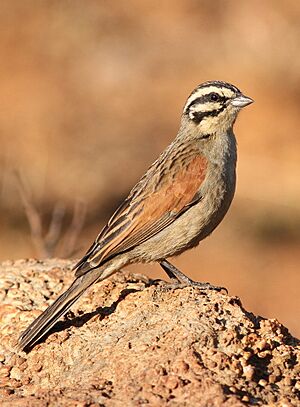Cape bunting facts for kids
Quick facts for kids Cape bunting |
|
|---|---|
 |
|
| Conservation status | |
| Scientific classification |
The Cape Bunting (Emberiza capensis) is a small bird that belongs to the bunting family. It's a type of passerine bird, which means it's a perching bird. You can find these birds in southern Africa.
Contents
About the Cape Bunting's Name
The Cape Bunting got its scientific name, Emberiza capensis, from a famous Swedish scientist named Carl Linnaeus. He named it in 1766. The word capensis means "from the Cape," referring to the Cape of Good Hope in South Africa.
There are ten slightly different types, or subspecies, of the Cape Bunting. They all have a special head pattern and reddish-brown (rufous) feathers on their wings. One subspecies, E. c. vincenti, looks darker and is sometimes considered a separate species.
What Does It Look Like?
The Cape Bunting is about 16 centimeters (6.3 inches) long. Adult birds have a black top of the head and a white stripe above their eyes. Their cheeks are white with a black border.
The upper part of their body is grey-brown with some dark stripes. Their wing feathers are a pretty chestnut color. The tail is a darker chestnut. The underside of the bird is grey, and its throat is pale. Male and female birds look very similar. However, females might have a slightly creamy color on their white head markings.
Young birds have duller wings and a less clear head pattern. They also have more streaks on their chest and sides. The Cape Bunting makes an ascending call that sounds like zzoo-zeh-zee-zee. Its song is a loud, chirping sound: chup chup chup chup chee chhep chu.
Where Does It Live?
The Cape Bunting lives in southern Africa. You can find it from southwestern Angola and eastern Zambia, all the way to Zimbabwe, southern Tanzania, and the Cape region.
These birds prefer rocky slopes and dry, scrubby areas. They mostly live in mountains in the northern parts of their range. They used to live in stony, dry areas with short grass. However, much of this land has been plowed for farming.
How Does It Behave?
The Cape Bunting is not a bird that gathers in large groups. You will usually see it alone, in pairs, or in small family groups. It finds its food on the ground. It eats seeds, insects, and spiders.
The female bird builds a cup-shaped nest. She builds it low in a shrub or a clump of grass. The nest is lined inside. She lays two to four eggs. The eggs are cream-colored and have red-brown and lilac markings.


